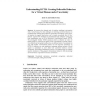Free Online Productivity Tools
i2Speak
i2Symbol
i2OCR
iTex2Img
iWeb2Print
iWeb2Shot
i2Type
iPdf2Split
iPdf2Merge
i2Bopomofo
i2Arabic
i2Style
i2Image
i2PDF
iLatex2Rtf
Sci2ools
HCI
2007
2007
Understanding RUTH: Creating Believable Behaviors for a Virtual Human Under Uncertainty
In pursuing the ultimate goal of enabling intelligent conversation with a virtual human, two key challenges are selecting nonverbal behaviors to implement and realizing those behaviors practically and reliably. In this paper, we explore the signals interlocutors use to display uncertainty face to face. Peoples’ signals were identified and annotated through systematic coding and then implemented onto our ECA (Embodied Conversational Agent), RUTH. We investigated whether RUTH animations were as effective as videos of talking people in conveying an agent’s level of uncertainty to human viewers. Our results show that people could pick up on different levels of uncertainty not only with another conversational partner, but also with the simulations on RUTH. In addition, we used animations containing different subsets of facial signals to understand in more detail how nonverbal behavior conveys uncertainty. The findings illustrate the promise of our methodology for creating specific inven...
Fine-grained Conversational Behaviors | HCI 2007 | Human Computer Interaction | Nonverbal Behavior | Uncertainty Face |
| Added | 29 Oct 2010 |
| Updated | 29 Oct 2010 |
| Type | Conference |
| Year | 2007 |
| Where | HCI |
| Authors | Insuk Oh, Matthew Stone |
Comments (0)

